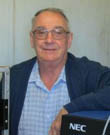|
|
 
|
|
Author
|
Topic: What is the value of a Simplex Standard?
|
|
|
|
|
|
|
Will Kutler
Phenomenal Film Handler

Posts: 1506
From: Tucson, AZ, USA
Registered: Feb 2001
|
 posted 06-27-2004 01:03 PM
posted 06-27-2004 01:03 PM




Standards, Supers and E-7s are all wonderful machines.
One problem with the Standards and Supers is that their shafts all rotated directly in the main-frame casting, and there were no inserted bearings to help prevent excessive wear or scoring. However, I have seen several of these machines operate smoothly, with no slop or roughness with worn and scorred shafts.
One possible solution that is one of my many "get-around-to-it" projects is to over-bore the mainframe casting and press-in oil-lite bushings.
As for the shafts, they are pretty much straight-forward machining and o-d grinding projects.
On the E-7s, the gears rotate on the shafts, and there would be little problem overboring the gears and inserting oil-lites.
The only potential problem I see is that there are a few areas that might result in thinning the main frame casting a little too much.
If adding oil-lites is possible, then yes, constant day-to-day usage of these machines would be more possible.
Vertical shaft Standards, Supers and E-7s are less prone to excessive gear wear than the oblique shaft E-7's. But one way to help reduce wear (besides meticulus cleaning and lubing) is to constantly repositioning shutter shaft gear in relation to the vertical/oblique shaft gear (by adjusting the machine), which will allow for an even wear of the shutter shaft gear.
There were also a couple of different gear tooth designs used for Standards, and I understand that one was better than the other. The pics and info are in the manuals on FT.
| IP: Logged
|
|
|
|
|
|
|
|
|
|
Will Kutler
Phenomenal Film Handler

Posts: 1506
From: Tucson, AZ, USA
Registered: Feb 2001
|
 posted 06-29-2004 12:27 AM
posted 06-29-2004 12:27 AM




Aaron
In actuality, the Standards were well built machines, and they are even capable of some things that some modern machines are not (like adjusting travel ghosting as needed, while the film is running).
Aaron, I have personally seen Standards and old Powers that looked like they were ready for the trash heap. They were simply disassembled, cleaned up and put back together. Even though some parts were worn, they still ran smooth! As I stated before, some of the problems can be solved by inserting bushings.
You degrade Standards...but you tend to forget that many companys cam into being by duplicating those machines...or at least serving as parts suppliers. You also forget that althoug "improved", many of the basic design concepts used on Standards are still incorporated into projectors today.
Have you ever had the chance to examine a Powers up close? Some of the craftsmanship that went into those machines is awesome, and would literally cost a fortune to do today!
| IP: Logged
|
|
|
|
|
|
|
|
|
|
|
|
|
|
|
|
All times are Central (GMT -6:00)
|
This topic comprises 11 pages: 1 2 3 4 ... 9 10 11
|
Powered by Infopop Corporation
UBB.classicTM
6.3.1.2
The Film-Tech Forums are designed for various members related to the cinema industry to express their opinions, viewpoints and testimonials on various products, services and events based upon speculation, personal knowledge and factual information through use, therefore all views represented here allow no liability upon the publishers of this web site and the owners of said views assume no liability for any ill will resulting from these postings. The posts made here are for educational as well as entertainment purposes and as such anyone viewing this portion of the website must accept these views as statements of the author of that opinion
and agrees to release the authors from any and all liability.
|

 Home
Home
 Products
Products
 Store
Store
 Forum
Forum
 Warehouse
Warehouse
 Contact Us
Contact Us




 Printer-friendly view of this topic
Printer-friendly view of this topic










![[Big Grin]](biggrin.gif) (Film Done Right?? I doubt it but the show went on).
(Film Done Right?? I doubt it but the show went on).![[uhoh]](graemlins/uhoh.gif)
![[thumbsup]](graemlins/thumbsup.gif)






